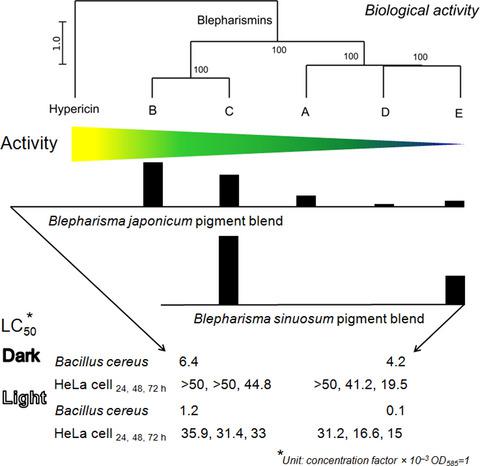当前位置:
X-MOL 学术
›
Photochem. Photobiol.
›
论文详情
Our official English website, www.x-mol.net, welcomes your feedback! (Note: you will need to create a separate account there.)
Distinguishing Activities in the Photodynamic Arsenals of the Pigmented Ciliates Blepharisma sinuosum Sawaya, 1940 and Blepharisma japonicum Suzuki, 1954 (Ciliophora: Heterotrichea)
Photochemistry and Photobiology ( IF 3.3 ) Pub Date : 2020-06-29 , DOI: 10.1111/php.13288 Jéssica Cavaleiro 1, 2 , Nathally B Oliveira 1, 2 , Talita A Ribeiro 1, 2 , Lohaine F Guimarães 1, 2 , Noemi M Fernandes 3 , Inácio D da Silva-Neto 3 , Flávia Marszaukowski 4 , Karen Wohnrath 4 , Cleber B Barreto 5 , Michael Schweikert 6 , Giulio Petroni 7 , Claudio Ortenzi 8 , Federico Buonanno 8 , Paulo H S Picciani 2, 9 , Osvaldo N Oliveira 10 , Carlos Augusto G Soares 1, 2
Photochemistry and Photobiology ( IF 3.3 ) Pub Date : 2020-06-29 , DOI: 10.1111/php.13288 Jéssica Cavaleiro 1, 2 , Nathally B Oliveira 1, 2 , Talita A Ribeiro 1, 2 , Lohaine F Guimarães 1, 2 , Noemi M Fernandes 3 , Inácio D da Silva-Neto 3 , Flávia Marszaukowski 4 , Karen Wohnrath 4 , Cleber B Barreto 5 , Michael Schweikert 6 , Giulio Petroni 7 , Claudio Ortenzi 8 , Federico Buonanno 8 , Paulo H S Picciani 2, 9 , Osvaldo N Oliveira 10 , Carlos Augusto G Soares 1, 2
Affiliation

|
Blepharismins are photodynamic hypericin‐like dianthrones produced as a variable pigment blend in Blepharisma ciliates and mostly studied in the Afro‐Asiatic Blepharisma japonicum. The present work describes the bioactivity of pigments from the Brazilian Blepharisma sinuosum. Comparative analyses showed that the pigments from both species can trigger photo‐induced modifications in phospholipids, but different redox properties and biological activities were assigned for each pigment blend. Stronger activities were detected for B. sinuosum pigments, with the lethal concentration LC50 10 × lower than B. japonicum pigments in light‐irradiated tests against Bacillus cereus and less than half for treatments on the human HeLa tumor cells. HPLC showed B. sinuosum producing a simpler pigment blend, mostly with the blepharismin‐C (~ 70%) and blepharismin‐E (~ 30%) types. Each blepharismin engaged a specific dose–response profile on sensitive cells. The blepharismin‐B and blepharismin‐C were the most toxic pigments, showing LC50 ~ 2.5–3.0 µm and ~ 100 µm on B. cereus and HeLa cells, respectively, after illumination. Similarity clustering analysis compiling the bioactivity data revealed two groups of blepharismins: the most active, B and C, and the less active, A, D and E. The B. sinuosum pigment blend includes one representative of each clade. Functional and medical implications are discussed.
中文翻译:

1940 年有色纤毛虫 Blepharisma sinuosum Sawaya 和 Blepharisma japonicum Suzuki,1954 年(纤毛虫:Heterotrichea)在光动力武器库中的区分活动
Blepharismins 是光动力金丝桃素样双蒽酮,在 Blepharisma ciliates 中作为可变色素混合物产生,主要在 Afro-Asiatic Blepharisma japonicum 中进行研究。目前的工作描述了巴西 Blepharisma sinuosum 色素的生物活性。比较分析表明,来自两种物种的色素都可以引发磷脂的光诱导修饰,但每种色素混合物具有不同的氧化还原特性和生物活性。检测到 B. sinuosum 色素的活性更强,在针对蜡状芽孢杆菌的光照射试验中,其致死浓度 LC50 比日本 B. japonicum 色素低 10 倍,而对人 HeLa 肿瘤细胞的治疗则不到一半。HPLC 显示 B. sinuosum 产生更简单的颜料混合物,主要是 blepharismin-C (~ 70%) 和 blepharismin-E (~ 30%) 类型。每个 blepharismin 对敏感细胞都有特定的剂量反应曲线。blepharismin-B 和 blepharismin-C 是毒性最强的色素,光照后,蜡状芽孢杆菌和 HeLa 细胞的 LC50 分别为~2.5-3.0 µm 和~100 µm。编制生物活性数据的相似性聚类分析揭示了两组 blepharismins:最活跃的 B 和 C,以及活性较低的 A、D 和 E。B. sinuosum 色素混合物包括每个进化枝的一个代表。讨论了功能和医学意义。照明后。编制生物活性数据的相似性聚类分析揭示了两组 blepharismins:最活跃的 B 和 C,以及活性较低的 A、D 和 E。B. sinuosum 色素混合物包括每个进化枝的一个代表。讨论了功能和医学意义。照明后。编制生物活性数据的相似性聚类分析揭示了两组 blepharismins:最活跃的 B 和 C,以及活性较低的 A、D 和 E。B. sinuosum 色素混合物包括每个进化枝的一个代表。讨论了功能和医学意义。
更新日期:2020-06-29
中文翻译:

1940 年有色纤毛虫 Blepharisma sinuosum Sawaya 和 Blepharisma japonicum Suzuki,1954 年(纤毛虫:Heterotrichea)在光动力武器库中的区分活动
Blepharismins 是光动力金丝桃素样双蒽酮,在 Blepharisma ciliates 中作为可变色素混合物产生,主要在 Afro-Asiatic Blepharisma japonicum 中进行研究。目前的工作描述了巴西 Blepharisma sinuosum 色素的生物活性。比较分析表明,来自两种物种的色素都可以引发磷脂的光诱导修饰,但每种色素混合物具有不同的氧化还原特性和生物活性。检测到 B. sinuosum 色素的活性更强,在针对蜡状芽孢杆菌的光照射试验中,其致死浓度 LC50 比日本 B. japonicum 色素低 10 倍,而对人 HeLa 肿瘤细胞的治疗则不到一半。HPLC 显示 B. sinuosum 产生更简单的颜料混合物,主要是 blepharismin-C (~ 70%) 和 blepharismin-E (~ 30%) 类型。每个 blepharismin 对敏感细胞都有特定的剂量反应曲线。blepharismin-B 和 blepharismin-C 是毒性最强的色素,光照后,蜡状芽孢杆菌和 HeLa 细胞的 LC50 分别为~2.5-3.0 µm 和~100 µm。编制生物活性数据的相似性聚类分析揭示了两组 blepharismins:最活跃的 B 和 C,以及活性较低的 A、D 和 E。B. sinuosum 色素混合物包括每个进化枝的一个代表。讨论了功能和医学意义。照明后。编制生物活性数据的相似性聚类分析揭示了两组 blepharismins:最活跃的 B 和 C,以及活性较低的 A、D 和 E。B. sinuosum 色素混合物包括每个进化枝的一个代表。讨论了功能和医学意义。照明后。编制生物活性数据的相似性聚类分析揭示了两组 blepharismins:最活跃的 B 和 C,以及活性较低的 A、D 和 E。B. sinuosum 色素混合物包括每个进化枝的一个代表。讨论了功能和医学意义。



























 京公网安备 11010802027423号
京公网安备 11010802027423号